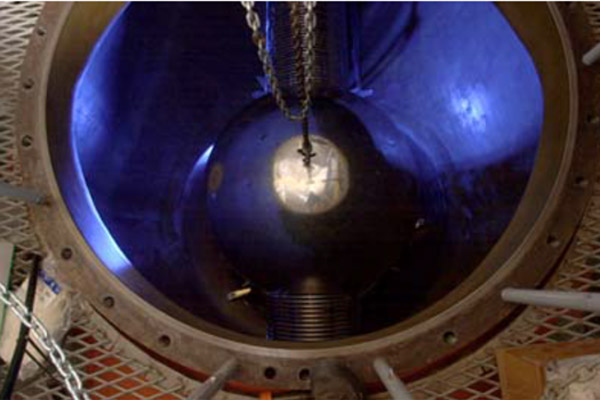By Adam Liebendorfer
Feb. 15, 2012
For a highly precise particle accelerator that hurls atoms at nearly the speed of light, the Edwards Accelerator Lab has the unpretentious feel of a garage. Hammers, nails, and power tools lie on the workbenches in the spartan concrete room. It’s not entirely a coincidence, as the lab has been hard at work this winter installing a new set of metal chains that can better generate electricity for the electrostatic accelerator.
Ohio University researchers started experiments in atomic physics at the Edwards Accelerator in 1971, making it one of the oldest accelerators still in use in the world, says physicist Carl Brune, director of the affiliated Institute of Nuclear and Particle Physics. Unlike its bigger cousins used by CERN and Fermilab, which use radio waves to propel their subatomic particles with billions or more volts, electrostatic accelerators use electricity generated by running belts against metal brushes to charge the particles, much like a Van de Graaff generator. The Edwards Accelerator normally clocks in at around 4.5 million volts. (How powerful is that? In comparison, local high-voltage power transmission lines are 11,000 volts.)
Much of the work at the lab involves testing how various materials, such as those used as computer components, react to being blasted by neutrons. The lab also has studied how radiation can be effectively used as cancer therapy. Other researchers, such as Brune, are looking to the cosmos. He studies how atoms fuse together to make carbon and oxygen atoms. Looking into these questions will give us a glimpse into the inner workings of stars, and ultimately the origins of the building blocks of our planet.
Turning 41 this year, the Edwards Accelerator has outlived most of its sister accelerators also built in the 1970s. In fact, it’s also outlived the company that built and supplied it. When High Voltage Engineering Company went out of business 10 years ago and the last of the custom-made charging belts gave way around 2005, researchers had to get creative with keeping the accelerator running.
“It was a bit awkward because the original company sold the technology to another company to make the belts, but that company was never successful at making them,” Brune says.
So the lab turned to commercial conveyor belts, but those had drawbacks. The new belts normally lasted only for 1,000 hours of use, whereas the older belts lasted ten times as long. The new belts also were notoriously prone to sparking and often short-circuited the facility, says lab chairman David Ingram.
“I forget how many belts that we’ve used, but let’s just say they didn’t last very long,” he says.
Three new pelletron chains, funded by a $320,000 grant from the National Science Foundation, will eliminate both problems, Brune says. These chains are made up of pellets that race up and down to produce the charge, much like the belts of old. In the pressurized central chamber, the chains are designed to keep sparking to a minimum.
The new chains are the latest in a long line of additions and upgrades to the accelerator over the years. Around 1990, an underground tunnel was dug for the accelerator so researchers could study the speed at which certain particles moved. In the mid-1990s, Michigan State gave the lab a beam swinger system, a rotating assembly at the opposite end of the accelerator that allows researchers to study reactions from different angles. The accelerator has gone through various cosmetic changes over the years: upgraded computers, new sensors, a forklift, expanded office space, and new paint on the walls.
The new pelletron chains come on the heels of the institute joining the Southern University Research Association, a group of universities dedicated to furthering the study of atomic physics. Ohio University researchers will have greater access to the association’s Jefferson Lab, home to another type of accelerator called the Continuous Electron Beam Accelerator Facility, which will help expand their research capabilities.



















Comments